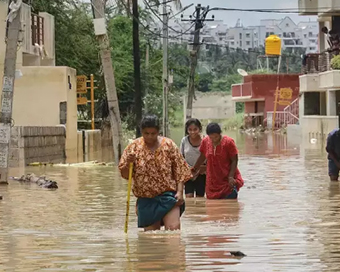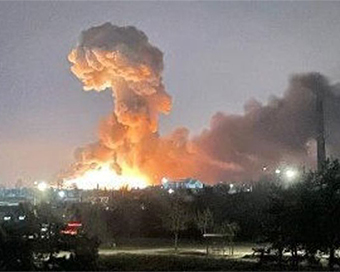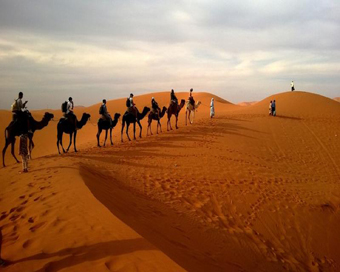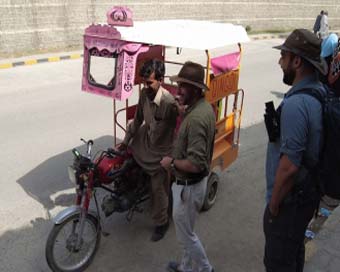 PM Modi visit USA
PM Modi visit USA Only the mirror in my washroom and phone gallery see the crazy me : Sara Khan
Only the mirror in my washroom and phone gallery see the crazy me : Sara Khan Karnataka rain fury: Photos of flooded streets, uprooted trees
Karnataka rain fury: Photos of flooded streets, uprooted trees Cannes 2022: Deepika Padukone stuns at the French Riviera in Sabyasachi outfit
Cannes 2022: Deepika Padukone stuns at the French Riviera in Sabyasachi outfit Ranbir Kapoor And Alia Bhatt's Wedding Pics - Sealed With A Kiss
Ranbir Kapoor And Alia Bhatt's Wedding Pics - Sealed With A Kiss Oscars 2022: Every Academy Award Winner
Oscars 2022: Every Academy Award Winner Shane Warne (1969-2022): Australian cricket legend's life in pictures
Shane Warne (1969-2022): Australian cricket legend's life in pictures Photos: What Russia's invasion of Ukraine looks like on the ground
Photos: What Russia's invasion of Ukraine looks like on the ground Lata Mangeshkar (1929-2022): A pictorial tribute to the 'Nightingale of India'
Lata Mangeshkar (1929-2022): A pictorial tribute to the 'Nightingale of India' PM Modi unveils 216-feet tall Statue of Equality in Hyderabad (PHOTOS)
PM Modi unveils 216-feet tall Statue of Equality in Hyderabad (PHOTOS)Hockey India has announced a 54-member core probable squad for the upcoming senior men’s
- Satwik-Chirag return as BAI names 14-strong squad for BWF Sudirman Cup Finals 2025
- Men’s Sr Hockey Nationals to be played in division-based format from April 4
- Mensik denies Djokovic 100th title in Miami final
- KIPG: Son of a vegetable vendor, Bihar’s Jhandu Kumar eyes Worlds, 2028 Paralympics
- Hardik Singh credits hard work and team unity for receiving HI Midfielder of the Year award
Humans to blame for creation of Sahara desert: Study Last Updated : 15 Mar 2017 03:09:22 PM IST 
(file photo) Challenging a commonly held theory that changes in the Earth's orbit triggered Sahara desertification, a new study suggests that humans may have played an active role in the transition of a lush green landscape into the world's largest hot desert thousands of years ago.
The desertification of the Sahara has long been a target for scientists trying to understand climate and ecological tipping points.
Most studies done to date point to changes in the Earth's orbit or natural changes in vegetation as the major driving forces.
In a new paper published in the journal Frontiers in Earth Science, David Wright from Seoul National University in South Korea challenges the conclusions of these studies.
"In East Asia there are long established theories of how Neolithic populations changed the landscape so profoundly that monsoons stopped penetrating so far inland," said Wright.
Evidence of human-driven ecological and climatic change has been documented in Europe, North America and New Zealand, said Wright who believed that similar scenarios could also apply to the Sahara.
To test his hypothesis, Wright reviewed archaeological evidence documenting the first appearances of pastoralism across the Saharan region, and compared this with records showing the spread of scrub vegetation, an indicator of an ecological shift towards desert-like conditions.
The findings confirmed his thoughts.
Beginning approximately 8,000 years ago in the regions surrounding the Nile River, pastoral communities began to appear and spread westward, increasing at the same time the spread of scrub vegetation, the study said.
Growing agricultural addiction had a severe effect on the region's ecology. As more vegetation was removed by the introduction of livestock, it increased the albedo (the amount of sunlight that reflects off the earth's surface) of the land, which in turn influenced atmospheric conditions sufficiently to reduce monsoon rainfall.
The weakening monsoons caused further desertification and vegetation loss, promoting a feedback loop which eventually spread over the entirety of the modern Sahara, the study said.
_
_SHOW_MID_AD__
For Latest Updates Please-
Join us on
Follow us on








172.31.16.186







